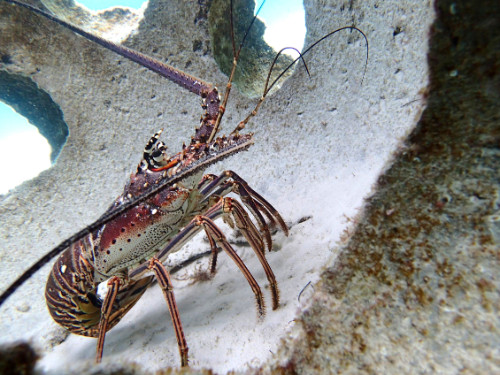|

|
 |
|
Last Updated: Mar 4, 2018 - 4:03:26 PM |

Marine Protected Areas safeguard about 6 million pounds of spiny lobster, worth almost 24 million dollars, every year. Protecting more breeding grounds would increase the annual output of this resource. CREDIT: BREEF
|
NASSAU, Bahamas - Marine Protected Areas safeguard about 6 million pounds of spiny lobster, worth almost 24 million dollars, every year. Protecting more breeding grounds would increase the annual output of this resource, according to a report commissioned by The Bahamas Protected project.
The “Economic Valuation of Ecosystem Services in Bahamian Marine Protected Areas” report was commissioned by The Bahamas Protected Project, a three-year initiative to manage and expand marine protected areas in the country in an effort to safeguard the economic value of marine ecosystems.
“It’s clear many of these protected areas contribute to the Bahamian economy by providing breeding grounds for the spiny lobster while ensuring the longevity of the fishing industry as a whole,” said BREEF Executive Director Casuarina McKinney-Lambert.
The country’s most valuable fisheries product is the spiny lobster with about 65 million dollars exported annually. In the animal’s early developmental stages it depends heavily on near shore habitats, including mangroves and sea grass beds to grow to a harvestable size. “Marine Protected Areas also have far reaching positive impacts on fisheries in general as well. This project seeks to use the best available science and to consult with fishermen and the public. We encourage people to attend the meetings scheduled during the months of March-May,” said Lashanti Jupp, Conservation Planner at the Bahamas National Trust.
“There are about 4,000 fishing boats manned by Bahamians who depend on the longevity of the fishing industry to survive,” stated Shenique Albury-Smith, Director of The Nature Conservancy Northern Caribbean Program. “Many Bahamians also rely on fish as a food source just to survive,” The report quantified how much nursery habitats, such as mangroves and sea grass areas, within marine protected areas, contribute to the protection of juvenile spiny lobster and in turn the annual production of spiny lobster in the fishery. Take for example the Exuma Cays Land & Sea Park in which the protected juvenile habitat sustains over 240,000 pounds of catch and $1 million in export value to fisheries outside the park boundaries.
The full report pointed out that the ecosystems within existing marine protected areas of The Bahamas have annual economic benefits of around 6 billion dollars. These economic benefits not only include the benefits of the spiny lobster habitats but also benefits from shoreline protection, touristic activity, and the benefits to the international community such as carbon storage in these areas that mitigate the worldwide carbon footprint and protect against climate change impacts.
“This helps us get a sense of the importance of the economic value of these habitats to this important fishery,” said Dr. Katie Arkema, the principle researcher on the report. “It also helps us understand the contribution of different regions and the contribution of Marine Protected Areas within those regions.” Dr. Arkema earned her Ph.D. in Ecology, Evolution and Marine Biology at the University of California, Santa Barbara and studies how environmental protection helps to safeguard individual communities and how this impacts economies. “This valuation helps to inform planning as well,” she said. “We can think of how to allocate resources to management and where we need to inform new developments so these developments don’t impact these nursery habitats.”
Bahamas Protected will be holding community meetings in New Providence and the Family Islands to get input and build support for the expansion of the Bahamian marine protected areas network. The expansion includes beaches, coral reefs, sand flats, and mangroves along with other features and is a part of The Caribbean Challenge Initiative that The Bahamas and 10 other countries signed to protect 20% of each country’s marine and coastal habitats by 2020.
“BNT has been carrying out community meetings throughout The Bahamas since the start of the project in 2016. We want to know how community members feel about marine protection in areas that we want to suggest for expansion, so far the feedback has been positive.” Says Lashanti Jupp, Conservation Planner with The Bahamas National Trust.
Bahamas Protected is a joint effort between The Nature Conservancy, the Bahamas National Trust, and BREEF in collaboration with other national stakeholders, with major funding support from Oceans 5. This study also had support from the Disney Conservation Fund and the Perry Institute for Marine Science. With about 10% of the Bahamas marine environment being declared a protected area, there is still much to do to add the next phase of protected areas and reach 20% protection by 2020. Follow Bahamas Protected Facebook page for more information (@242protected), and sign the petition at Hyperlink

© Copyright 2018 by thebahamasweekly.com
Top of Page
|
|
 |

|
